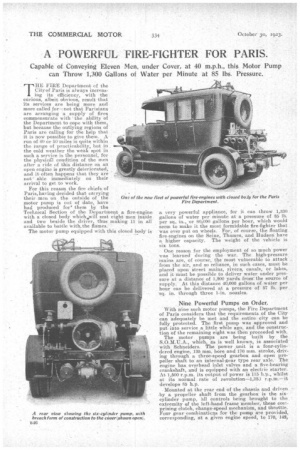A POWERFUL FIRE-FIGHTER FOR PARIS.
Page 32

Page 33

If you've noticed an error in this article please click here to report it so we can fix it.
Capable of Conveying Eleven Men, under Cover, at 40 m.p.h., this Motor Pump can Throw 1,300 Gallons of Water per Minute at 85 lbs. Pressure.
THE FIRE Department of the Cityof Paris is always increasing its efficiency, with the carious, albeit obvious, result that its services are being more and more called for—not that Parisians are arranging a supply of fires commensurate with ' the ability of the Department to cope with them, but because the outlying regions of Paris are calling for the help that it is now possible to give them. A run of 40 or 50 miles is quite, within the range of practicability, but in the cold weather the weak spot in such a service is the personnel, for the physical condition of the men after a ride of this distance on an open engine is greatly deteriorated, and. itoften happens that they are note able immediately on their arrival to get to work.
Far this reason the fire chiefs of Paris, having decided that carrying their-men on the outside of the motor pump is out of date, have had produced ford them by the Technical Section of the Department a fire-engine with a closed body' which.will seat eight men inside and two beside the driver, thus making 11 in all available to battle With_the flames. .
The motor pump equipped with this closed body is a very powerful appliance, for it can throw 1,330 gallons of water per minute at a pressure of 85 lb. per see in., or 80,000 gallons per hour, which would seem to make it the most formidable fire-fighter that was ever put on wheels. For, of course the floating
fire-engines on the Seine, Thames, and course, have a higher capacity. The weight of the vehicle is six tons.
One reason for the employment of so much power was learned during the war. The high-pressure mains are, of course, the most vulnerable to attack from the air, and so reliance, in such cases, must be placed upon street mains, rivers, canals, or lakes, and it must be possible to delive,r water under pressure at a distance of 1,200 yards from-the source of supply. At this distance 40,000 gallons of water per hour can be delivered at a pressure of 57 lb. per, -sq. in. through three 1-in. nozzles.
Nine Powerful Pumps on Order.
With nine such motor pumps, the Fire Department of Paris considers that the requirements of the City can adequately be met and the entire city can be fully protected. The first pump was approved and put into service a little while ago, and the construction of the remaining eight was then proceeded with. The motor pumps are being built by the S.O.M.U.A., which, as is well known, is associated with Schneiders. The power unit is a four-cylintiered engine, 135 mm. bore and 170 mm. stroke, driving through a three-speed gearbox and open propeller shaft to an internal-gear type rear axle. The engine has overhead inlet valves and a five-bearing crankshaft, and is equipped with an electric starter. At 1,500 r.p.m. its output of power is 115 hp., whilst at its normal rate of revolution-1,353 r.p.m.—it develops 85 h.p.
Mounted at the rear end of the chassis and driven by a propeller shaft from the gearbox is the sixcylinder pump, all controls being brought to the extremity af the left-hand frame member, these cowprising clutch, change-speed mechanism, and throttle. Four gear-combinations far the pump are provided, corresponding, at a given engine speed, to 170, 142,
113, and 85 lb. pregsure per sq. in. The six cylinders are disposed round a horizontal axis, the water inlet pipes being at the rear below the frame members and the inlets being at the sides of the pump.A cannon breech form of construction is employed, to give rapid access to the interior of the pump, for rectification of faults or for cleaning.
The vehicle is mounted -on large pneumatic tyres, and can attain a speed of 40 m.p.h. A high-speed tender, mounted on a pnetimatic-tyred Delahaye chassis, is designed to work with the new pump and to carry the supply of hose. The main feed pipes from the pump are connected up to the tender, and the water is delivered through a 2-in, nozzle mounted permanently on the top of the tender and having universal joint which allows it to be turned in any direction by one man. In addition to this main nozzle, the delivery can be made through three nozzles of 1.1 in. diameter or twelve .7-in., or 24 half-inch nozzles. Working' without the tender, the motor pump can supply direct through six delivery pipes— three placed on each side of the pump unit.




































